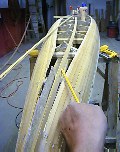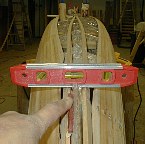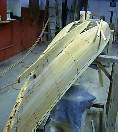
 |
||||
| INDEX | next
|
 |
The
following stripping technique shows that you can create concave (hollow)
surfaces with strips that rival any composite craft made in a mold. Wood strips are often flexible to contour just about most curved surfaces with a normal parallel stripping technique. There is a limit, however, in the case of hollows or concave surfaces forming at the base of skeg-like keels and sterns. Sometimes, even 5/8" bead & cove strips refuse to twist and bend into the right shape . A large percentage of strips starts to break unless steamed. If they don't break, they will pull off the stations, changing the hull shape and altering the performance of the kayak. The solution to this problem rests in changing the stripping pattern to reduce the severity of the compound bending. Any kayak with a sharp keel at the stern is a good subject for this technique. The Cape Ann Expedition is one of them. Strip the hull to the point when the strips really start to refuse to conform. Take a new strip and run it roughly in the middle of the deepest hollow on the stations and almost parallel to the keel. You will notice that the absence of compound twist (bending in two directions and twisting at the same time) makes the strip quite pliable and easy to hold down. |
 |
The next step is to staple on a symmetrical counterpart to get a point of reference when the other side is stripped over. Here, I am using a torpedo level to make a fine adjustment to get the strips even and level. Staple them down firmly and make sure the curve they form looks fair(smooth) to you. |
 |
The
keel is easily stripped now. Do one side first, then the other. |
| INDEX |
| Home | Kayak Designs | Kayak Shop | Materials | Kayak Gallery | About us |
| Building Manual | Plans | Sandwich Core | Wood Kayak | Order | |
| Epoxy Test | Abrasion Cloth | Rudder | Resources | Choosing Kayak | Guestbook |
If you notice any problems with the site (i.e. error links, missing images) please, let me know. Thanks
Mail:
Vaclav Stejskal
10 Colonial Court apt. 73
Stoneham, MA. 02180
USA
Tel: 781-481-9261
© 1999
- 2020 Copyright Vaclav Stejskal
All rights reserved
Last page update:
11 January 2020